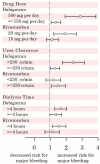Dabigatran and rivaroxaban use in atrial fibrillation patients on hemodialysis
- PMID: 25595139
- PMCID: PMC4363265
- DOI: 10.1161/CIRCULATIONAHA.114.014113
Dabigatran and rivaroxaban use in atrial fibrillation patients on hemodialysis
Abstract
Background: Dabigatran and rivaroxaban are new oral anticoagulants that are eliminated through the kidneys. Their use in dialysis patients is discouraged because these drugs can bioaccumulate to precipitate inadvertent bleeding. We wanted to determine whether prescription of dabigatran or rivaroxaban was occurring in the dialysis population and whether these practices were safe.
Methods and results: Prevalence plots were used to describe the point prevalence (monthly) of dabigatran and rivaroxaban use among 29977 hemodialysis patients with atrial fibrillation. Poisson regression compared the rate of bleeding, stroke, and arterial embolism in patients who started dabigatran, rivaroxaban, or warfarin. The first record of dabigatran prescription among hemodialysis patients occurred 45 days after the drug became available in the United States. Since then, dabigatran and rivaroxaban use in the atrial fibrillation-end-stage renal disease population has steadily risen where 5.9% of anticoagulated dialysis patients are started on dabigatrian or rivaroxaban. In covariate adjusted Poisson regression, dabigatran (rate ratio, 1.48; 95% confidence interval, 1.21-1.81; P=0.0001) and rivaroxaban (rate ratio, 1.38; 95% confidence interval, 1.03-1.83; P=0.04) associated with a higher risk of hospitalization or death from bleeding when compared with warfarin. The risk of hemorrhagic death was even larger with dabigatran (rate ratio, 1.78; 95% confidence interval, 1.18-2.68; P=0.006) and rivaroxaban (rate ratio, 1.71; 95% confidence interval, 0.94-3.12; P=0.07) relative to warfarin. There were too few events in the study to detect meaningful differences in stroke and arterial embolism between the drug groups.
Conclusions: More dialysis patients are being started on dabigatran and rivaroxaban, even when their use is contraindicated and there are no studies to support that the benefits outweigh the risks of these drugs in end-stage renal disease.
Keywords: atrial fibrillation; dabigatran; dialysis; rivaroxaban; warfarin.
© 2015 American Heart Association, Inc.
Figures



References
-
- Gage BF. Can we rely on RE-LY? N Engl J Med. 2009;361:1200–2. - PubMed
-
- [2013 Nov 9];FDA approves Xarelto to prevent stroke in people with common type of abnormal heart rhythm [Internet] Available from: http://www.fda.gov/NewsEvents/Newsroom/PressAnnouncements/ucm326654.htm.
-
- Connolly SJ, Ezekowitz MD, Yusuf S, Eikelboom J, Oldgren J, Parekh A, Pogue J, Reilly PA, Themeles E, Varrone J, Wang S, Alings M, Xavier D, Zhu J, Diaz R, Lewis BS, Darius H, Diener H-C, Joyner CD, Wallentin L. Dabigatran versus warfarin in patients with atrial fibrillation. N Engl J Med. 2009;361:1139–51. - PubMed
-
- Patel MR, Mahaffey KW, Garg J, Pan G, Singer DE, Hacke W, Breithardt G, Halperin JL, Hankey GJ, Piccini JP, Becker RC, Nessel CC, Paolini JF, Berkowitz SD, Fox KAA, Califf RM. Rivaroxaban versus warfarin in nonvalvular atrial fibrillation. N Engl J Med. 2011;365:883–891. - PubMed
Publication types
MeSH terms
Substances
Grants and funding
LinkOut - more resources
Full Text Sources
Other Literature Sources
Medical

